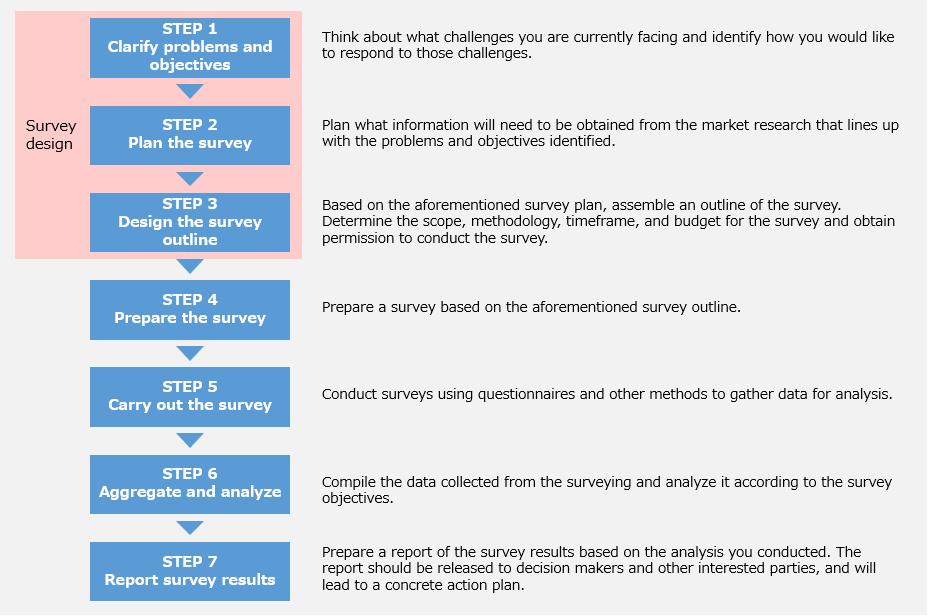Designing Market Research Surveys|Process and Tips

Some people in charge of market research may not know where to start with survey designs.
This article goes over some steps and tips for designing a survey in order to conduct better market research.
When a company has to solve a business problem, it is critical to obtain information about the market and the users. For example, when the sales of a new product are not growing as expected or if a previously well-performing store sees a decline, it may be difficult to home in on what the exact problem is or how to rectify the situation. Market research is used to avoid or answer these sorts of problems. By obtaining information from the market and users, market research can guide the company in a direction which it should go. Even if the direction ends up being wrong, it is possible to identify the problem in the data and apply that knowledge to the next step.
Market Research Flow
The market research process is as follows.

It is very important to build consensus among the relevant parties at each stage of market research. Failure to eliminate differences in understanding among the parties involved, especially in the initial stages, can lead to a significant loss of time and money. It is important to clearly present the decisions that need to be made at each stage and keep the agreements in a clear form.
What is Survey Design?
Survey design plays a crucial role in shaping what content market research handles. If we were to compare survey design to architecture, it would be the drafting of a design document. If you look to the “Market Research Flow” section above, you will see survey design is encompassed by STEPs 1 through 3. Survey design has a very large impact on the overall survey process. It is fair to state that the quality of market research largely hinges on the effectiveness of the survey design.
The Need for Survey Design
The problems faced by organizations are diverse and change dramatically with the needs of the times. In some cases, the data that needs to be obtained through surveys is qualitative, such as user psychology, while in other cases it is quantitative, such as hard numerical data. The survey methods and implementation must be carefully constructed according to these needs.
Survey design involves effectively integrating various elements such as the survey objectives, the desired data to be gathered as well as the appropriate survey methods and implementation strategies. Its purpose is to guide the market research process in a way that ultimately yields valuable and actionable insights.
The results of surveys create value only when they help an organization make decisions. If they do not yield that value, the survey will have no value, no matter how much effort is put into it. The most important step in making a survey valuable to an organization is the survey design.
Survey Design Procedure
This section goes through the steps required for survey design. Mistakes made during survey design can have a major impact later on. In each step, consider how to eliminate confusion and ambiguity as much as you possibly can.
1.Clarify marketing issues
The first step in survey design is to clearly identify the marketing issues. In simpler terms, what are the problems? For example, are you experiencing declining sales at an existing storefront, poor sales of a new product or has website traffic stagnated? Start by clearly defining the issues your team is facing.
2.Setting survey objectives
Once the marketing issue, or problem, has been identified, dig deeper into the cause of the facts behind the occurrence. It is important to note that you should avoid simply turning the problem upside down. For example, reasoning “existing store sales are declining, so we need to increase existing store sales,” is overly simplistic and leads to no concrete solutions to the problem. It is critical to dig deeper into the root of the problem and identify the cause through investigation. To do this, place “why” before the problem.
Why are store sales declining? Because the number of customers is declining.
Why is the number of customers declining? Because our repeat customers are visiting less frequently.
Why are repeat customers visiting our stores less frequently? (This is what we need to know!)
By doing this we prefix a why to just the facts and answer them as factually and objectively as we possibly can. At some point in this process, you will no longer be able to produce an answer to the question. That question that cannot be answered with facts is the information we want to obtain through market research. Once you have identified the information you want to obtain, think about what action you want to take once you have that information.
We want to understand the decline in the frequency of repeat customer visits and then:
- Implement sales promotions
- Acquire product feedback
- Improve the store’s image
3.Analyze the current situation
Once the survey objectives have been set, gather the information available at the current stage and analyze the situation. Let’s consider a case where the objective is to understand the reason for the decline in the frequency of repeat customer visits and link it to promotional activities. In this case, the situation analysis might look something like:
- Is this decrease limited to just repeat customers?
- Are there any standout patterns in terms of age, gender, or region in the decrease?
- Is the decrease specific to your company or is it industry-wide?
- What is the competitive relationship among the declining stores?
- What is the difference in image between your company’s stores and your competitors’ stores?
In this situational analysis stage the available data is limited, so it may not always be possible to conduct a precise analysis. However, by delving deeper into the analysis, some insights for solving your problem might make themselves apparent. In fact, the ability to uncover these insights is a crucial skill for survey designers. The quality of survey design greatly depends on the accuracy of this analysis. Therefore, it is recommended to seek the input of external experts to go along with your internal analysis.
4.Hypothesize
Once you have identified some key insights from the analysis of the current situation, formulate a hypothesis regarding the underlying cause of the problem using those insights as a basis.
- Is it possible that the image of Competitor A’s store has risen, reducing the comparative attractiveness of your store?
- Is it possible the image of Competitor A’s store matches the needs of the repeat customer base?
- Is there a discrepancy between the needs of repeat customers and the image your company is developing?
By developing a hypothesis like this, you will be able to gauge the direction of the specific information you want to obtain. It is important to keep in mind that a hypothesis is only an assumption. It does not necessarily mean that the hypothesis we have made is on target. Therefore, we should not limit ourselves to a single hypothesis, but rather formulate a second or even a third hypothesis.
5.Envision actions to be taken after the survey
Once a hypothesis has been developed, the next step is to envision the actions that will be taken if the hypothesis ends up being supported. While a supported hypothesis is valuable information, if it does not lead to concrete actions which means the marketing issue will not be solved. Think about what actions you can take to follow up on this hypothesis. Post-survey actions should be envisioned with a good mix of these two points: Not too idealistic but not too beholden to the status quo.
6.Plan the survey
Once the marketing issue, survey objectives, hypotheses, and post-survey actions are in place, the next step is to create a survey plan.
What kind of people should be surveyed? (Survey target)
The target population will be determined based on the survey objectives and considers the required sample size and allocation.
What kind of research should be conducted to obtain the information you want to know? (Research methods)
The selection of survey methods will depend on the survey objectives and the type of data to be obtained. The main survey methods are as follows.
Quantitative survey
- Online surveys (Web-based surveys)
- Venue survey (CLT)
- Home-use survey
- Mail survey
Qualitative research
- Group survey seminar
- In-depth survey interview
- Behavioral observation survey
- Diary survey
What is the deadline to deliver specific actions from the survey results? (Deadline)
Work backwards from the date of required action and figure out when the survey results are needed by.
How much budget can you allocate to the survey? (Budget)
Confirm in advance the budget you can allocate to the survey and the scale of the survey you wish to conduct.
Survey Design Tips
The skill and experience of the person in charge of survey design is crucial. While there are many design tips we could provide, we will focus on two key points here.
The first is to embrace a hypothesis-driven mindset. Hypothesis-driven thinking entails having a conscious understanding of “why?” When approaching a task, asking yourself why allows you to comprehend the underlying reasons behind it. This, in turn, enables you to anticipate the context and background for why it is being sought. This ability to anticipate is the essence of hypothesis-driven thinking. Developing this skill enhances your understanding of the core issues and translates into effective survey design. Cultivate your ability to think about the “why” by questioning various problems and developing your hypothesis-driven thinking skills.
The second is seeking guidance from knowledgeable individuals. In any endeavor, including survey design, relying solely on trial and error as an inexperienced person can be rather inefficient. While learning through trial and error has its merits, it requires a considerable amount of time and a forgiving and conducive environment. Begin by seeking advice from experts and learn how to craft survey designs. As you gain experience, you will steadily enhance your survey design skills.
Summary
Survey design is a crucial step for carrying out successful market research. If executed effectively, it can greatly contribute to resolving identified marketing issues. There are various aspects to consider, and numerous tasks to be accomplished. If you find yourself losing direction, reflect on the fundamental purpose of the research and proceed with the appropriate survey design.
Author
Asmark Editorial Office
Marketing Communications Group , Sales Department, Asmarq Corporation
They oversee all of Asmarq’s website content and are also involved in the development of new research solutions and branding. They also contribute to planning marketing research seminars and writing research-related content.
Supervision: Asmarq Marketing Communications Group


